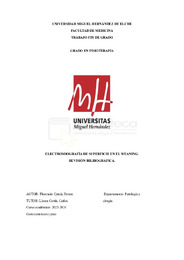Please use this identifier to cite or link to this item:
https://hdl.handle.net/11000/33572Full metadata record
| DC Field | Value | Language |
|---|---|---|
| dc.contributor.advisor | Llorca Cerdá, Carlos | - |
| dc.contributor.author | Florencio Catalá, Ferrán | - |
| dc.contributor.other | Departamentos de la UMH::Patología y Cirugía | es_ES |
| dc.date.accessioned | 2024-10-21T12:18:23Z | - |
| dc.date.available | 2024-10-21T12:18:23Z | - |
| dc.date.created | 2024-05-31 | - |
| dc.identifier.uri | https://hdl.handle.net/11000/33572 | - |
| dc.description.abstract | Introducción: La ventilación mecánica es un recurso de soporte vital utilizado cuando las capacidades respiratorias se ven comprometidas. Afecta a varios aspectos funcionales de la respiración, como el intercambio gaseoso, la mecánica respiratoria y la interacción entre el corazón y los pulmones. Este método conlleva complicaciones asociadas al tiempo de uso, como problemas en la vía aérea, debilidad muscular, daño al diafragma, toxicidad por oxígeno e infecciones o neumonía asociada a la ventilación mecánica. Estas complicaciones pueden aumentar la morbimortalidad, subrayando la importancia de una delicada extubación. Objetivos: Investigar si el empleo de técnicas no invasivas, como la electromiografía de superficie aplicada a los músculos respiratorios, puede ser útil para guiar y monitorear el proceso de destete en la ventilación mecánica. Material y métodos: Búsqueda bibliográfica en diferentes bases de datos: Pubmed, PEDro, Scopus, Science Direct y Cochrane, incluyendo un total de 15 artículos a partir del 2004. Resultados: Con un total de 356 sujetos en proceso de destete, 8 artículos evaluaron los músculos diafragma, intercostales y paraesternales. 11 informaron de la frecuencia de muestreo y el ancho de banda de la señal de EMGs. Conclusiones: Dentro de los protocolos para la UCI, se concluye que el diafragma y los músculos paraesternales son los más útiles y efectivos, así como los métodos de colocación de los electrodos relacionados. Además, se observa que el músculo diafragma exhibe una mayor actividad cuando el paciente está en posición supina o semisentada. | es_ES |
| dc.description.abstract | Introduction: Mechanical ventilation is a life support resource used when respiratory capabilities are compromised. It affects several functional aspects of breathing, such as gas exchange, respiratory mechanics and the interaction between the heart and lungs. This method has complications associated with time of use, such as airway problems, muscle weakness, damage to the diaphragm, oxygen toxicity and infections or ventilator-associated pneumonia. These complications may increase morbidity and mortality, underlining the importance of gentle extubation. Objectives: To investigate whether the use of non-invasive techniques, such as surface electromyography applied to the respiratory muscles, can be useful to guide and monitor the weaning process in mechanical ventilation. Material and methods: Bibliographic search in different databases: Pubmed, PEDro, Scopus, Science Direct and Cochrane, including a total of 15 articles from 2004. Results: With a total of 356 weaning subjects, 8 articles assessed the diaphragm, intercostal and parasternal muscles. 11 reported the sampling frequency and bandwidth of the EMGs signal. Conclusions: Within the ICU protocols, it is concluded that the diaphragm and parasternal muscles are the most useful and effective, as well as the related electrode placement methods. In addition, it is observed that the diaphragm muscle exhibits greater activity when the patient is in the supine or semi-supine position. | es_ES |
| dc.format | application/pdf | es_ES |
| dc.format.extent | 47 | es_ES |
| dc.language.iso | spa | es_ES |
| dc.publisher | Universidad Miguel Hernández | es_ES |
| dc.rights | info:eu-repo/semantics/openAccess | es_ES |
| dc.rights | Attribution-NonCommercial-NoDerivatives 4.0 Internacional | * |
| dc.rights.uri | http://creativecommons.org/licenses/by-nc-nd/4.0/ | * |
| dc.subject | Electromiografía de superficie | es_ES |
| dc.subject | Destete | es_ES |
| dc.subject | Músculos respiratorios | es_ES |
| dc.subject | Ventilación mecánica prolongada | es_ES |
| dc.subject.other | CDU::6 - Ciencias aplicadas | es_ES |
| dc.title | Electromiografía de superficie en el weaning. Revisión bibliográfica | es_ES |
| dc.type | info:eu-repo/semantics/bachelorThesis | es_ES |

View/Open:
TFG FLORENCIO CATALÁ, FERRAN.pdf
1,17 MB
Adobe PDF
Share:
.png)
